高中英语语法过去分词 done
- 格式:ppt
- 大小:135.50 KB
- 文档页数:12
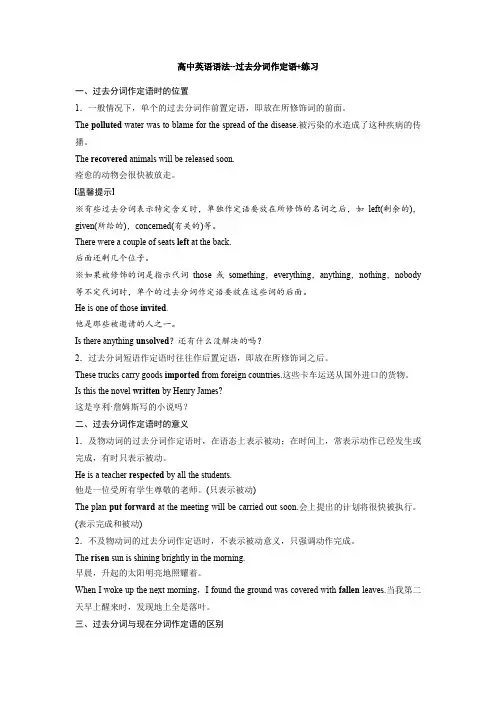
高中英语语法--过去分词作定语+练习一、过去分词作定语时的位置1.一般情况下,单个的过去分词作前置定语,即放在所修饰词的前面。
The polluted water was to blame for the spread of the disease.被污染的水造成了这种疾病的传播。
The recovered animals will be released soon.痊愈的动物会很快被放走。
温馨提示※有些过去分词表示特定含义时,单独作定语要放在所修饰的名词之后,如left(剩余的),given(所给的),concerned(有关的)等。
There were a couple of seats left at the back.后面还剩几个位子。
※如果被修饰的词是指示代词those或something,everything,anything,nothing,nobody 等不定代词时,单个的过去分词作定语要放在这些词的后面。
He is one of those invited.他是那些被邀请的人之一。
Is there anything unsolved?还有什么没解决的吗?2.过去分词短语作定语时往往作后置定语,即放在所修饰词之后。
These trucks carry goods imported from foreign countries.这些卡车运送从国外进口的货物。
Is this the novel written by Henry James?这是亨利·詹姆斯写的小说吗?二、过去分词作定语时的意义1.及物动词的过去分词作定语时,在语态上表示被动;在时间上,常表示动作已经发生或完成,有时只表示被动。
He is a teacher respected by all the students.他是一位受所有学生尊敬的老师。
(只表示被动)The plan put forward at the meeting will be carried out soon.会上提出的计划将很快被执行。
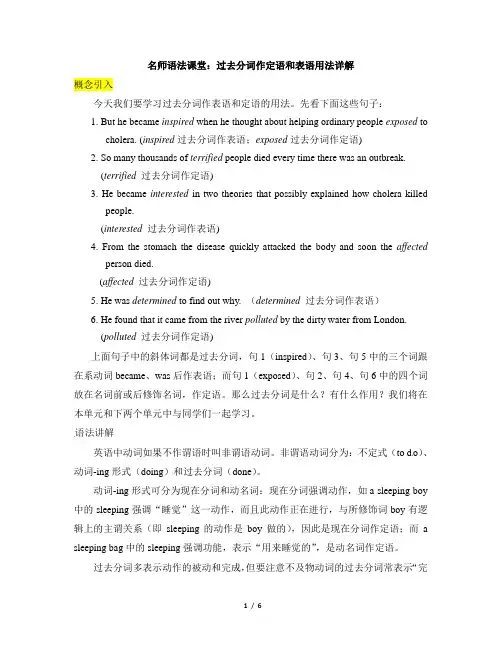
名师语法课堂:过去分词作定语和表语用法详解概念引入今天我们要学习过去分词作表语和定语的用法。
先看下面这些句子:1. But he became inspired when he thought about helping ordinary people exposed tocholera. (inspired过去分词作表语;exposed过去分词作定语)2. So many thousands of terrified people died every time there was an outbreak.(terrified过去分词作定语)3. He became interested in two theories that possibly explained how cholera killedpeople.(interested 过去分词作表语)4. From the stomach the disease quickly attacked the body and soon the affectedperson died.(affected过去分词作定语)5. He was determined to find out why. (determined过去分词作表语)6. He found that it came from the river polluted by the dirty water from London.(polluted过去分词作定语)上面句子中的斜体词都是过去分词,句1(inspired)、句3、句5中的三个词跟在系动词became、was后作表语;而句1(exposed)、句2、句4、句6中的四个词放在名词前或后修饰名词,作定语。
那么过去分词是什么?有什么作用?我们将在本单元和下两个单元中与同学们一起学习。
语法讲解英语中动词如果不作谓语时叫非谓语动词。
非谓语动词分为:不定式(to d o)、动词-ing形式(doing)和过去分词(done)。
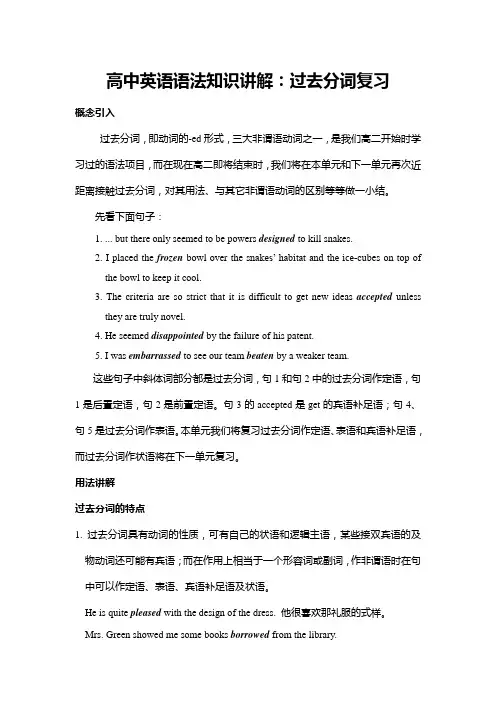
高中英语语法知识讲解:过去分词复习概念引入过去分词,即动词的-ed形式,三大非谓语动词之一,是我们高二开始时学习过的语法项目,而在现在高二即将结束时,我们将在本单元和下一单元再次近距离接触过去分词,对其用法、与其它非谓语动词的区别等等做一小结。
先看下面句子:1. ... but there only seemed to be powers designed to kill snakes.2. I placed the frozen bowl over the s nakes’ habitat and the ice-cubes on top ofthe bowl to keep it cool.3. The criteria are so strict that it is difficult to get new ideas accepted unlessthey are truly novel.4. He seemed disappointed by the failure of his patent.5. I was embarrassed to see our team beaten by a weaker team.这些句子中斜体词部分都是过去分词,句1和句2中的过去分词作定语,句1是后置定语,句2是前置定语。
句3的accepted是get的宾语补足语;句4、句5是过去分词作表语。
本单元我们将复习过去分词作定语、表语和宾语补足语,而过去分词作状语将在下一单元复习。
用法讲解过去分词的特点1. 过去分词具有动词的性质,可有自己的状语和逻辑主语,某些接双宾语的及物动词还可能有宾语;而在作用上相当于一个形容词或副词,作非谓语时在句中可以作定语、表语、宾语补足语及状语。
He is quite pleased with the design of the dress. 他很喜欢那礼服的式样。
Mrs. Green showed me some books borrowed from the library.格林先生给我看一些从图书馆借来的书。

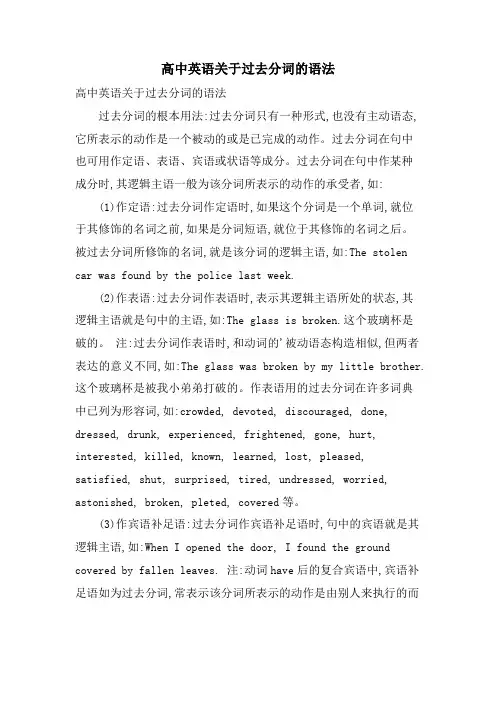
高中英语关于过去分词的语法高中英语关于过去分词的语法过去分词的根本用法:过去分词只有一种形式,也没有主动语态,它所表示的动作是一个被动的或是已完成的动作。
过去分词在句中也可用作定语、表语、宾语或状语等成分。
过去分词在句中作某种成分时,其逻辑主语一般为该分词所表示的动作的承受者,如:(1)作定语:过去分词作定语时,如果这个分词是一个单词,就位于其修饰的名词之前,如果是分词短语,就位于其修饰的名词之后。
被过去分词所修饰的名词,就是该分词的逻辑主语,如:The stolen car was found by the police last week.(2)作表语:过去分词作表语时,表示其逻辑主语所处的状态,其逻辑主语就是句中的主语,如:The glass is broken.这个玻璃杯是破的。
注:过去分词作表语时,和动词的'被动语态构造相似,但两者表达的意义不同,如:The glass was broken by my little brother.这个玻璃杯是被我小弟弟打破的。
作表语用的过去分词在许多词典中已列为形容词,如:crowded, devoted, discouraged, done, dressed, drunk, experienced, frightened, gone, hurt, interested, killed, known, learned, lost, pleased, satisfied, shut, surprised, tired, undressed, worried, astonished, broken, pleted, covered等。
(3)作宾语补足语:过去分词作宾语补足语时,句中的宾语就是其逻辑主语,如:When I opened the door, I found the ground covered by fallen leaves. 注:动词have后的复合宾语中,宾语补足语如为过去分词,常表示该分词所表示的动作是由别人来执行的而不是句中主语自己来执行的,如:I had my bike repaired yesterday. 昨天我(找别人)把我的自行车给修了。
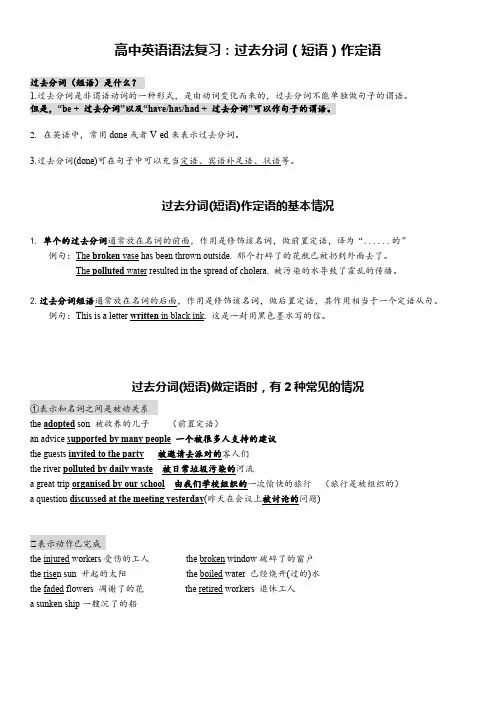
高中英语语法复习:过去分词(短语)作定语过去分词(短语)是什么?1.过去分词是非谓语动词的一种形式,是由动词变化而来的,过去分词不能单独做句子的谓语。
但是,“be + 过去分词”以及“have/has/had + 过去分词”可以作句子的谓语。
2.在英语中,常用done或者V-ed来表示过去分词。
3.过去分词(done)可在句子中可以充当定语、宾语补足语、状语等。
过去分词(短语)作定语的基本情况1.单个的过去分词通常放在名词的前面,作用是修饰该名词,做前置定语,译为“......的”例句:The broken vase has been thrown outside. 那个打碎了的花瓶已被扔到外面去了。
The polluted water resulted in the spread of cholera. 被污染的水导致了霍乱的传播。
2.过去分词短语通常放在名词的后面,作用是修饰该名词,做后置定语,其作用相当于一个定语从句。
例句:This is a letter written in black ink. 这是一封用黑色墨水写的信。
过去分词(短语)做定语时,有2种常见的情况①表示和名词之间是被动关系the adopted son 被收养的儿子(前置定语)an advice supported by many people 一个被很多人支持的建议the guests invited to the party被邀请去派对的客人们the river polluted by daily waste被日常垃圾污染的河流a great trip organised by our school由我们学校组织的一次愉快的旅行(旅行是被组织的)a question discussed at the meeting yesterday(昨天在会议上被讨论的问题)②表示动作已完成the injured workers受伤的工人the broken window破碎了的窗户the risen sun 升起的太阳the boiled water 已经烧开(过的)水the faded flowers 凋谢了的花the retired workers 退休工人a sunken ship一艘沉了的船【过去分词(短语)做定语时的特殊情况】①left,given,concerned,discussed, found, built, invited, mentioned, obtained, received, questioned, shown, told 等是单个的过去分词,但是,通常会放在名词后面作后置定语。
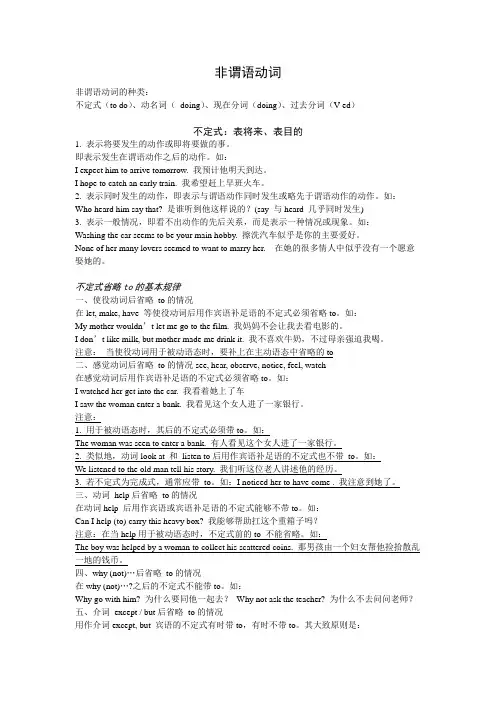
非谓语动词非谓语动词的种类:不定式(to do)、动名词(doing)、现在分词(doing)、过去分词(V-ed)不定式:表将来、表目的1. 表示将要发生的动作或即将要做的事。
即表示发生在谓语动作之后的动作。
如:I expect him to arrive tomorrow. 我预计他明天到达。
I hope to catch an early train. 我希望赶上早班火车。
2. 表示同时发生的动作,即表示与谓语动作同时发生或略先于谓语动作的动作。
如:Who heard him say that? 是谁听到他这样说的?(say 与heard 几乎同时发生)3. 表示一般情况,即看不出动作的先后关系,而是表示一种情况或现象。
如:Washing the car seems to be your main hobby. 擦洗汽车似乎是你的主要爱好。
None of her many lovers seemed to want to marry her. 在她的很多情人中似乎没有一个愿意娶她的。
不定式省略to的基本规律一、使役动词后省略to的情况在let, make, have 等使役动词后用作宾语补足语的不定式必须省略to。
如:My mother wouldn’t let me go to the film. 我妈妈不会让我去看电影的。
I don’t like milk, but mother made me drink it. 我不喜欢牛奶,不过母亲强迫我喝。
注意:当使役动词用于被动语态时,要补上在主动语态中省略的to二、感觉动词后省略to的情况see, hear, observe, notice, feel, watch在感觉动词后用作宾语补足语的不定式必须省略to。
如:I watched her get into the car. 我看着她上了车I saw the woman enter a bank. 我看见这个女人进了一家银行。
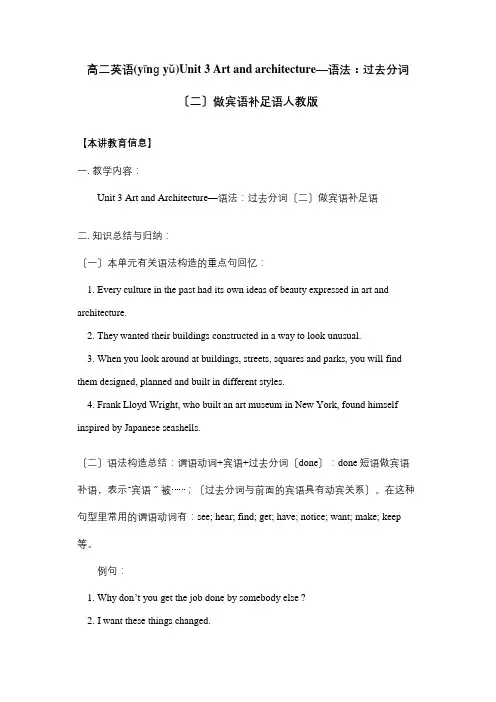
高二英语(yīnɡ yǔ)Unit 3 Art and architecture—语法:过去分词〔二〕做宾语补足语人教版【本讲教育信息】一. 教学内容:Unit 3 Art and Architecture—语法:过去分词〔二〕做宾语补足语二. 知识总结与归纳:〔一〕本单元有关语法构造的重点句回忆:1. Every culture in the past had its own ideas of beauty expressed in art and architecture.2. They wanted their buildings constructed in a way to look unusual.3. When you look around at buildings, streets, squares and parks, you will find them designed, planned and built in different styles.4. Frank Lloyd Wright, who built an art museum in New York, found himself inspired by Japanese seashells.〔二〕语法构造总结:谓语动词+宾语+过去分词〔done〕:done短语做宾语补语,表示“宾语〞被……;〔过去分词与前面的宾语具有动宾关系〕。
在这种句型里常用的谓语动词有:see; hear; find; get; have; notice; want; make; keep 等。
例句:1. Why don’t you get the job done by somebody else ?2. I want these things changed.3. The police found a car abandoned by the roadside.4. She felt a great load taken off her mind.5. You might as well have our wall whitewashed.6. Although we may not realize it, when we talk with others we make ourselves understood not just by words. We send messages to the people around us also by our expression and body movement.〔三〕have something done 构造的不同(bù tónɡ)意义:〔1〕找人做这件事〔2〕已经做了这件事〔3〕使……遭受例句:1. Many town and villages had their water supply cut off because there was no electricity.2. I have had all the branches cut up for firewood.3. “Can’t you read this notice ? You need to have your eyes tested.〞 She said to me in surprise.4. I had my pocket picked in the bus.5. He has had his hands burned.〔四〕动词不定式,分词〔-ing形式;dine〕做宾补的意义比拟:动词+宾语+宾语补语。
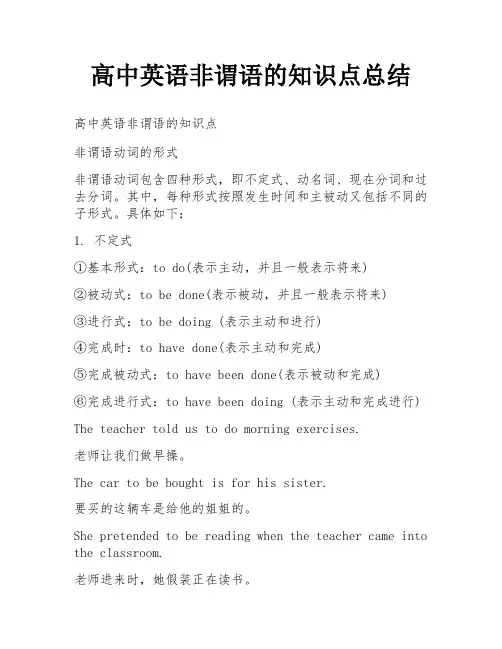
高中英语非谓语的知识点总结高中英语非谓语的知识点非谓语动词的形式非谓语动词包含四种形式,即不定式、动名词、现在分词和过去分词。
其中,每种形式按照发生时间和主被动又包括不同的子形式。
具体如下:1. 不定式①基本形式:to do(表示主动,并且一般表示将来)②被动式:to be done(表示被动,并且一般表示将来)③进行式:to be doing (表示主动和进行)④完成时:to have done(表示主动和完成)⑤完成被动式:to have been done(表示被动和完成)⑥完成进行式:to have been doing (表示主动和完成进行)The teacher told us to do morning exercises.老师让我们做早操。
The car to be bought is for his sister.要买的这辆车是给他的姐姐的。
She pretended to be reading when the teacher came into the classroom.老师进来时,她假装正在读书。
The thief is said to have escaped.据说小偷已经逃跑了。
The thief is said to have been arrested.据说小偷已经被抓住了。
She is said to have been working in the factory over the last 20 years.据说在过去的20年里,她一直在这家工厂工作。
2. 动名词①基本形式:doing (表示主动)②被动式:being done(表示被动)③完成式:having done(表示主动和完成)④完成被动式:having been done(表示被动和完成)Travelling in space by ordinary people will be mon in the future.在未来,普通人在太空旅行将会是普遍的事情。
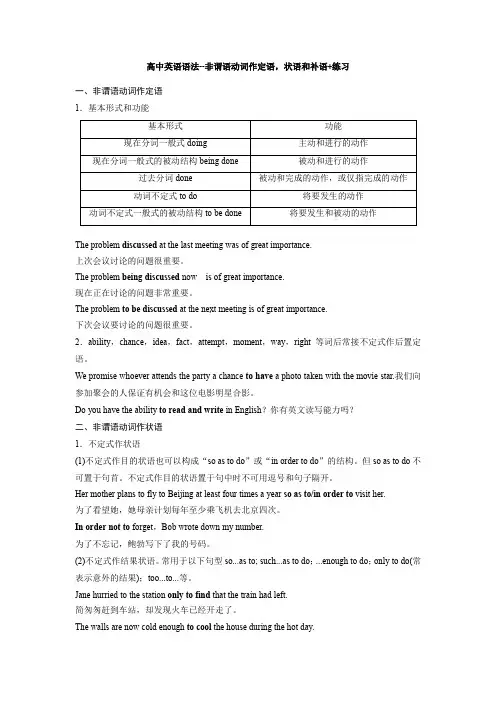
高中英语语法--非谓语动词作定语,状语和补语+练习一、非谓语动词作定语1.基本形式和功能The problem discussed at the last meeting was of great importance.上次会议讨论的问题很重要。
The problem being discussed now is of great importance.现在正在讨论的问题非常重要。
The problem to be discussed at the next meeting is of great importance.下次会议要讨论的问题很重要。
2.ability,chance,idea,fact,attempt,moment,way,right等词后常接不定式作后置定语。
We promise whoever attends the party a chance to have a photo taken with the movie star.我们向参加聚会的人保证有机会和这位电影明星合影。
Do you have the ability to read and write in English?你有英文读写能力吗?二、非谓语动词作状语1.不定式作状语(1)不定式作目的状语也可以构成“so as to do”或“in order to do”的结构。
但so as to do不可置于句首。
不定式作目的状语置于句中时不可用逗号和句子隔开。
Her mother plans to fly to Beijing at least four times a year so as to/in order to visit her.为了看望她,她母亲计划每年至少乘飞机去北京四次。
In order not to forget,Bob wrote down my number.为了不忘记,鲍勃写下了我的号码。
(2)不定式作结果状语。
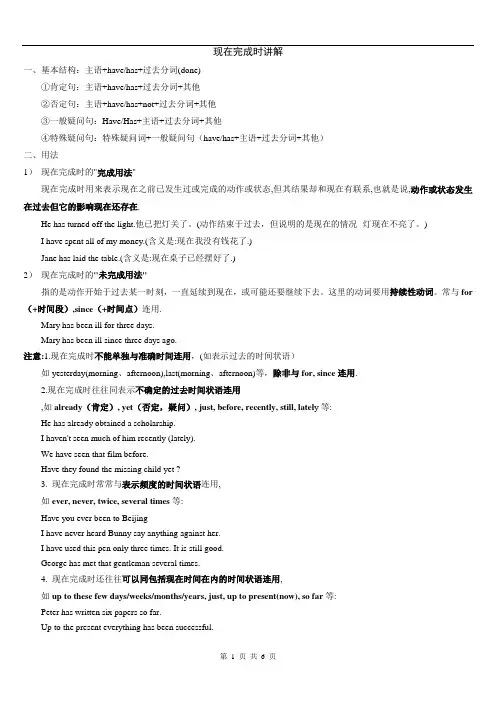
现在完成时讲解一、基本结构:主语+have/has+过去分词(done)①肯定句:主语+have/has+过去分词+其他②否定句:主语+have/has+not+过去分词+其他③一般疑问句:Have/Has+主语+过去分词+其他④特殊疑问句:特殊疑问词+一般疑问句(have/has+主语+过去分词+其他)二、用法1)现在完成时的"完成用法"现在完成时用来表示现在之前已发生过或完成的动作或状态,但其结果却和现在有联系,也就是说,动作或状态发生在过去但它的影响现在还存在.He has turned off the light.他已把灯关了。
(动作结束于过去,但说明的是现在的情况--灯现在不亮了。
)I have spent all of my money.(含义是:现在我没有钱花了.)Jane has laid the table.(含义是:现在桌子已经摆好了.)2)现在完成时的"未完成用法"指的是动作开始于过去某一时刻,一直延续到现在,或可能还要继续下去。
这里的动词要用持续性动词。
常与for (+时间段),since(+时间点)连用.Mary has been ill for three days.Mary has been ill since three days ago.注意:1.现在完成时不能单独与准确时间连用,(如表示过去的时间状语)如yesterday(morning、afternoon),last(morning、afternoon)等,除非与for, since连用.2.现在完成时往往同表示不确定的过去时间状语连用,如already(肯定), yet(否定,疑问), just, before, recently, still, latel y等:He has already obtained a scholarship.I haven't seen much of him recently (lately).We have seen that film before.Have they found the missing child yet ?3. 现在完成时常常与表示频度的时间状语连用,如ever, never, twice, several times等:Have you ever been to BeijingI have never heard Bunny say anything against her.I have used this pen only three times. It is still good.George has met that gentleman several times.4. 现在完成时还往往可以同包括现在时间在内的时间状语连用,如up to these few days/weeks/months/years, just, up to present(now), so far等:Peter has written six papers so far.Up to the present everything has been successful.5. 现在完成时还可以用来表示过去的一个时间到现在这段时间内重复发生的动作.We have had four texts this semester.6. have been to 和have gone to的区别have been to 强调“去过”,现已不在那里,如:He has been to the USA three times.他到美国去过三次。
非谓语动词-----过去分词done语法填空1.作定语单个过去分词作定语一般置于所修饰名词前,短语则放在所修饰词后。
Eg: the retired scientistPeople trapped in the lift若所修饰词由some/any/no+nothing/body/one及these,those等时放其后Eg: Is there anything unsolved。
过去分词短语可作非限制性定语,前后常用逗号隔开。
The book, written by Lu Xun, are popular with many Chinese people.Exercise 1:1).When first _____(introduce)to the market, these products enjoyed great success.2).Linda worked for the Manufacturing and Mining Company, _______(know)as 3M3).The disc, digitally_____(record)in the studio, sounded fantastic at the party that night.4). ______(Adapt)from Jane Austin’s classic, the BBC production Pride an d prejudice isuniversally acknowledged as the best so far.(2012 苏北四模)5). So far nobody has claimed the money_______(discover)in the library.(2010 湖南)2.作表语表示主语的心理感受或所处状态Eg: Don’t touch the glass because it is broken.She is quite pleased with the design of the dress.作表语与被动语态的区别Eg: The glass is broken.It was broken by my sister.过去分词和现在分词作表语的区别。
现在完成时讲解一、基本结构:主语+have/has+过去分词(done)①肯定句:主语+have/has+过去分词+其他②否定句:主语+have/has+not+过去分词+其他③一般疑问句:Have/Has+主语+过去分词+其他④特殊疑问句:特殊疑问词+一般疑问句(have/has+主语+过去分词+其他)二、用法1)现在完成时的"完成用法"现在完成时用来表示现在之前已发生过或完成的动作或状态,但其结果却和现在有联系,也就是说,动作或状态发生在过去但它的影响现在还存在.He has turned off the light.他已把灯关了。
(动作结束于过去,但说明的是现在的情况--灯现在不亮了。
)I have spent all of my money.(含义是:现在我没有钱花了.)Jane has laid the table.(含义是:现在桌子已经摆好了.)2)现在完成时的"未完成用法"指的是动作开始于过去某一时刻,一直延续到现在,或可能还要继续下去。
这里的动词要用持续性动词。
常与for (+时间段),since(+时间点)连用.Mary has been ill for three days.Mary has been ill since three days ago.注意:1.现在完成时不能单独与准确时间连用,(如表示过去的时间状语)如yesterday(morning、afternoon),last(morning、afternoon)等,除非与for, since连用.2.现在完成时往往同表示不确定的过去时间状语连用,如already(肯定), yet(否定,疑问), just, before, recently, still, latel y等:He has already obtained a scholarship.I haven't seen much of him recently (lately).We have seen that film before.Have they found the missing child yet ?3. 现在完成时常常与表示频度的时间状语连用,如ever, never, twice, several times等:Have you ever been to BeijingI have never heard Bunny say anything against her.I have used this pen only three times. It is still good.George has met that gentleman several times.4. 现在完成时还往往可以同包括现在时间在内的时间状语连用,如up to these few days/weeks/months/years, just, up to present(now), so far等:Peter has written six papers so far.Up to the present everything has been successful.5. 现在完成时还可以用来表示过去的一个时间到现在这段时间内重复发生的动作.We have had four texts this semester.6. have been to 和have gone to的区别have been to 强调“去过”,现已不在那里,如:He has been to the USA three times.他到美国去过三次。
高中英语语法非谓语动词非谓语动词包括不定式(to do)、动名词(-ing)、现在分词(-ing)与过去分词(-ed)。
它们不受主语人称和数的限制,在句子中不能充当谓语,但可以充当句子的其他成分,并且有时态和语态的变化。
动词不定式定义:动词不定式是非谓语动词的一种,它没有人称和数的变化,在句子中不能独立作谓语,但它仍保持动词的特点,可以有自己的宾语和状语。
主动形式被动形式一般式to do to be done一.不定式的意义1.不定式的一般式:一般式表示的动作或状态发生在谓语动词表示的动作或状态的同时或之后。
当不定式的逻辑主语是这个不定式所表示的动作的承受者时,不定式一般要用被动式(to be done).e.g.He seemed to be tired.The building to be finished next month is for our teachers.2.不定式的进行式:进行式表示动作正在进行,与谓语的动作同时发生。
e.g.When I went to his home,he happened to be traveling around the world.3.不定式的完成式:如果不定式所表示的动作或状态发生在谓语动词所表示动作或状态之前,就用完成式;若是在此基础上的被动含义,就用完成被动式(to have been done).e.g.He is said to have written a novel about the Long March.He is said to have been taught French when he was a child.4.不定式的完成进行式:如果不定式的动作是在谓语所表示的时间之前一直在进行或有可能继续进行的动作,就要用完成进行式.e.g.We’re happy to have been working with the experts all the month.二.不定式的用法1.不定式做主语:不定式做主语一般表示具体的某次动作。
done在句子中的位置摘要:I.引言- 介绍句子和done 在句子中的位置II.done 在句子的不同位置及其含义- 1.作为句子的谓语动词- 2.作为句子的助动词- 3.作为句子的情态动词III.done 在句子中的语法功能- 1.表示完成动作- 2.表示被动语态- 3.表示动作发生在过去IV.结论- 总结done 在句子中的位置及其重要性正文:I.引言在英语语法中,done 作为助动词和情态动词,在句子中有多种位置。
本文将详细讨论done 在句子中的不同位置及其含义、语法功能。
II.done 在句子的不同位置及其含义1.作为句子的谓语动词当done 作为句子的谓语动词时,它表示动作已经完成。
例如:“I havedone my homework.”(我已经完成了我的家庭作业。
)2.作为句子的助动词在句子中,done 作为助动词时,通常位于主要动词之前。
例如:“She looks done.”(她看起来已经筋疲力尽。
)3.作为句子的情态动词作为情态动词时,done 表示说话者对某事情已经完成的确信。
例如:“I can"t believe she"s done it!”(我简直不能相信她已经完成了!)III.done 在句子中的语法功能1.表示完成动作当done 作为谓语动词时,它表示动作已经完成。
例如:“I have done my homework.”(我已经完成了我的家庭作业。
)2.表示被动语态当done 作为助动词时,它可以表示被动语态。
例如:“The cak e was done by her.”(蛋糕是被她完成的。
)3.表示动作发生在过去当done 作为情态动词时,它表示动作发生在过去。
例如:“She looks done.”(她看起来已经筋疲力尽。
)IV.结论总之,done 在句子中有多种位置和含义。
作为谓语动词,它表示动作已经完成;作为助动词,它表示被动语态;作为情态动词,它表示说话者对某事情已经完成的确信。